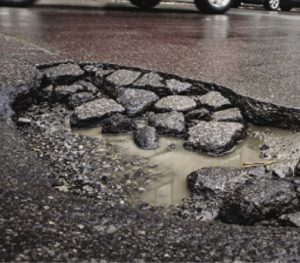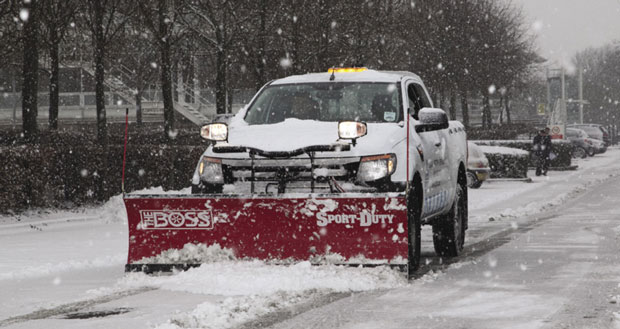GETTING READY FOR THE RAINS
One of the defining features of the British climate is rainfall, which is why it’s vital to ensure that drainage systems are working as they should ahead of winter. Again, this is an area where planned maintenance is important to ensure drains can handle the expected conditions. The Met Office has warned that the UK will see an increase in the number of “high impact heavy rainfall” days, with intense and prolonged rainfall seeing a rise in flooding. While drainage systems are not designed for flash flooding, proactive measures such as CCTV drainage surveys and high-pressure water jetting will ensure that they can operate at their optimal level.
The needs of sites will vary, but inspections and cleaning of drains should be undertaken at least once a year. A recommendation is that this is done around September time to remove leaves and debris that have been washed into drains and to ensure the drainage system can run at full capacity over winter. Ideally, that process should be repeated in March to cope with build up over winter. As well as camera surveys of drains, inspections should also look for  obvious issues on site like ponding in car parks, – an obvious sign that water can’t get away, depressions that could indicate a collapsed drain, or to identify and clear vegetation in drainage gullies that would impact their effectiveness.
obvious issues on site like ponding in car parks, – an obvious sign that water can’t get away, depressions that could indicate a collapsed drain, or to identify and clear vegetation in drainage gullies that would impact their effectiveness.
Obviously, prevention is cheaper than the cure and this is certainly the case with drainage, where expensive excavation and drain repairs can be prevented with effective planned maintenance. Hence, regular planned drain cleansing and site surveys can ensure any potential issues can be identified and dealt with before becoming an expensive problem. For example, techniques and methods such as no dig and pipe relining repairs, can ensure that drainage issues can be rectified with minimal disruption and without the need for expensive excavations. In other words, scheduling inspections to help with winter readiness can also help manage costs over the long term. It’s also worth keeping in mind that organisations have a duty of care to maintain drainage and failures to do so – for example in the case of spills on site – could result in fines from the water authority.
PLAN PROPERLY FOR SNOW AND ICE CLEARANCE
Clearly, many of winter’s greatest risks come in the form of snow and ice. Over one of the harshest winters of recent years, 2017/18, Hospital Episode Statistics for England recorded over 7,200 people requiring hospital treatment after slipping on snow or ice. These are figures that organisations can’t afford to ignore: Litigation follows hot on the heels of cold weather accidents and ‘slipping on ice’ accidents have the potential for the highest value claims and compensation.
Planning for winter should be well under way months in advance. Yet worryingly, many organisations approach winter in a poor state of readiness: Every year, our winter maintenance team receives multiple desperate calls from businesses finding their arrangements for snow and ice clearing falling short – whether its emergency cover needed when a contractor fails to show, or even requests for quotes arriving as the snow starts falling. This ad hoc approach that treats cold conditions as an afterthought can even be seen in otherwise highly professional FM operations. A striking example we encountered was a state-of-the-art fulfilment centre brought to a halt due to compacted snow that had turned the loading areas into ice rinks. In that case, leaving the task of clearing ice to poorly trained staff caused a just-in-time supply chain to grind to a halt.
Taking a proactive and fully managed approach to winter maintenance is key to business continuity, preventing accidents and mitigating potential liability claims. Whether outsourcing to expert contractors or carrying out work in house, your adverse weather policy should clearly communicate how your organisation will manage/take action in extreme weather situations. Key aspects of any effective plan include:
- Use of a recognised health and safety management system (e.g OHSAS18001) to ensure the plan is fit for purpose.
- Clearly defined and communicated responsibilities for teams on the ground and within management.
- A process for documenting proactive actions, incidents and investigations undertaken with records kept for three years minimum.
- Ensuring the plan is based on
detailed surveys to identify hazard areas and that action is undertaken according to real time accurate weather data and agreed action triggers for service. - Adequate resourcing with either professional contractors or a dedicated trained in-house team, sufficient and well-maintained equipment.
- Clearly defined KPIs to measure performance against and a process to review the plan and any KPIs on a regular basis (at least bi-annually).
Underpinning all of this is a proactive, professional mindset that looks to anticipate and pre-empt seasonal risks. Estates management is about managing risk but it’s also about priorities and understanding where best to invest the energies of your organisation and when to bring in the right skills to take on the breadth of challenges.





